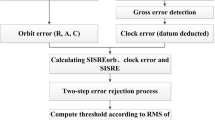Abstract
This paper used the statistical methods of quality control to assess receiver autonomous integrity monitoring (RAIM) availability and fault detection (FD) capability of BeiDou14 (Phase II with 14 satellites), BeiDou (Phase III with 35 satellites) and GPS (with 31 satellites) for the first time. The three constellations are simulated and their RAIM performances are quantified by the global, Asia-Pacific region and temporal variations respectively. RAIM availability must be determined before RAIM detection. It is proposed that RAIM availability performances from satellites and constellation geometry configuration are evaluated by the number of visible satellites (NVS, NVS > 5) and geometric dilution of precision (GDOP, GDOP < 6) together. The minimal detectable bias (MDB) and minimal detectable effect (MDE) are considered as a measure of the minimum FD capability of RAIM in the measurement level and navigation position level respectively. The analyses of simulation results testify that the average global RAIM performances for BeiDou are better than that for GPS except global RAIM holes proportion. Moreover, the Asia-Pacific RAIM performances for BeiDou are much better than that for GPS in all indexes. RAIM availability from constellation geometry configuration and RAIM minimum FD capability for BeiDou14 are better than that for GPS in Asia-Pacific region in all cases, but the BeiDou14 RAIM availability from satellites are worse than GPS’s. The methods and conclusions can be used for RAIM prediction and real-time assessment of all kinds of Global Navigation Satellite Systems (GNSS) constellation.
Similar content being viewed by others
References
BDS-SIS-ICD-B1I-1.0, BeiDou navigation satellite system signal in space interface control document-open service signal b1I (version 1.0) [S].
Teunissen P J G. Quality control and GPS [M]//Teunissen P J G, Kleusberg A. GPS for geodesy. 2nd ed. Berlin: Springer Verlag, 1998.
Teunissen P J G. Minimal detectable biases of GPS data [J]. Journal of Geodesy, 1998, 72(4): 236–244.
Ochieng W Y, Sheridan K F, Sauer K, et al. An assessment of the RAIM performance of a combined Galileo/GPS navigation system using the marginally detectable errors (MDE) algorithm [J]. GPS Solutions, 2002, 5(3): 42–51.
Verhagen S. Performance analysis of GPS, Galileo and integrated GPS-Galileo [Ch]//ION GPS 2002. Portland, OR, USA: The Institute of Navigation, 2002: 2208–2215.
Wu F, Kubo N, Yasuda A. Performance evaluation of GPS augmentation using Japanese Quasi-Zenith satellite system [J]. Earth Planets Space, 2004, 40(4): 1249–1260.
Hewitson S, Wang J. GNSS receiver autonomous integrity monitoring (RAIM) performance analysis [J]. GPS Solutions, 2006, 10(3): 155–170.
692-5720, Air force space command capstone requirements document for global position, velocity, and time determination capability (draft) [S].
692-5720, Air force space command capstone requirements document for global position, velocity, and time determination capability (draft) [S].
Walter T, Enge P, Blanch J, et al. Worldwide vertical guidance of aircraft based on modernized GPS and new integrity augmentations [J]. Proceedings of the IEEE, 2008, 96(12): 1918–1935.
Gratton L, Joerger M, Pervan B. Carrier phase relative RAIM algorithms and protection level derivation [C]//Proceedings of the 2009 International Technical Meeting of the Institute of Navigation. Anaheim, CA, USA: The Institute of Navigation, 2010: 256–264.
GNSS Evolutionary Architecture Study. GNSS evolutionary architecture study, phase II — panel report [R]. Washington D C, USA: Federal Aviation Administration, 2010.
Xu H, Wang J, Zhan X. GNSS satellite autonomous integrity monitoring (SAIM) using inter-satellite measurements [J]. Advances in Space Research, 2011, 47(7): 1116–1126.
Parkinson B W, Spilker J J, Axelrad P, et al. Global positioning system: Theory and applications (volume II) [M]. Washington D C: AIAA, 1996.
Tiberius C, Joosten P. Quality control and integrity [EB/OL]. (2006-11-01) [2013-05-03]. http://www.citg.tudelft.nl/over-faculteit/afdelingen/geoscience-and-remote-sensing/research-themes/gps/quality-control-and-integrity/.
Hewitson S. Quality control for integrated GNSS and inertial navigation systems [D]. Kensington, NSW, Australia: School of Surveying and Spatial Information Systems, the University of New South Wales, 2006.
Verhagen S. Studying the performance of global navigation satellite systems: A new software tool [J]. GPS World, 2002, 13(6): 60–65.
Ober P B. RAIM performance: How algorithms differ [C]//The Proceedings of the 11th International Technical Meeting of the Satellite Division of the Institute of Navigation (ION GPS-98). Nashville, Tennessee: The Institute of Navigation, 1998.
GPS-SPS-PS, Global positioning system standard positioning service performance standard (4th edition) [S].
Teunissen P J G. Quality control in integrated navigation systems [J]. IEEE Aerospace and Electronic Systems Magazine, 1990, 5(7): 35–41.
Author information
Authors and Affiliations
Corresponding author
Additional information
Foundation item: the National High Technology Research and Development Program (863) of China (No. 2011AA120503)
Rights and permissions
About this article
Cite this article
Su, Xl., Zhan, Xq., Niu, Mc. et al. Receiver autonomous integrity monitoring availability and fault detection capability comparison between BeiDou and GPS. J. Shanghai Jiaotong Univ. (Sci.) 19, 313–324 (2014). https://doi.org/10.1007/s12204-014-1505-7
Received:
Published:
Issue Date:
DOI: https://doi.org/10.1007/s12204-014-1505-7
Key words
- Global Navigation Satellite Systems (GNSS)
- BeiDou Navigation Satellite System (BDS)
- GPS
- receiver autonomous integrity monitoring (RAIM)
- availability
- fault detection (FD)
- quality control




